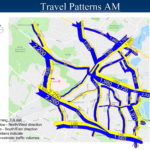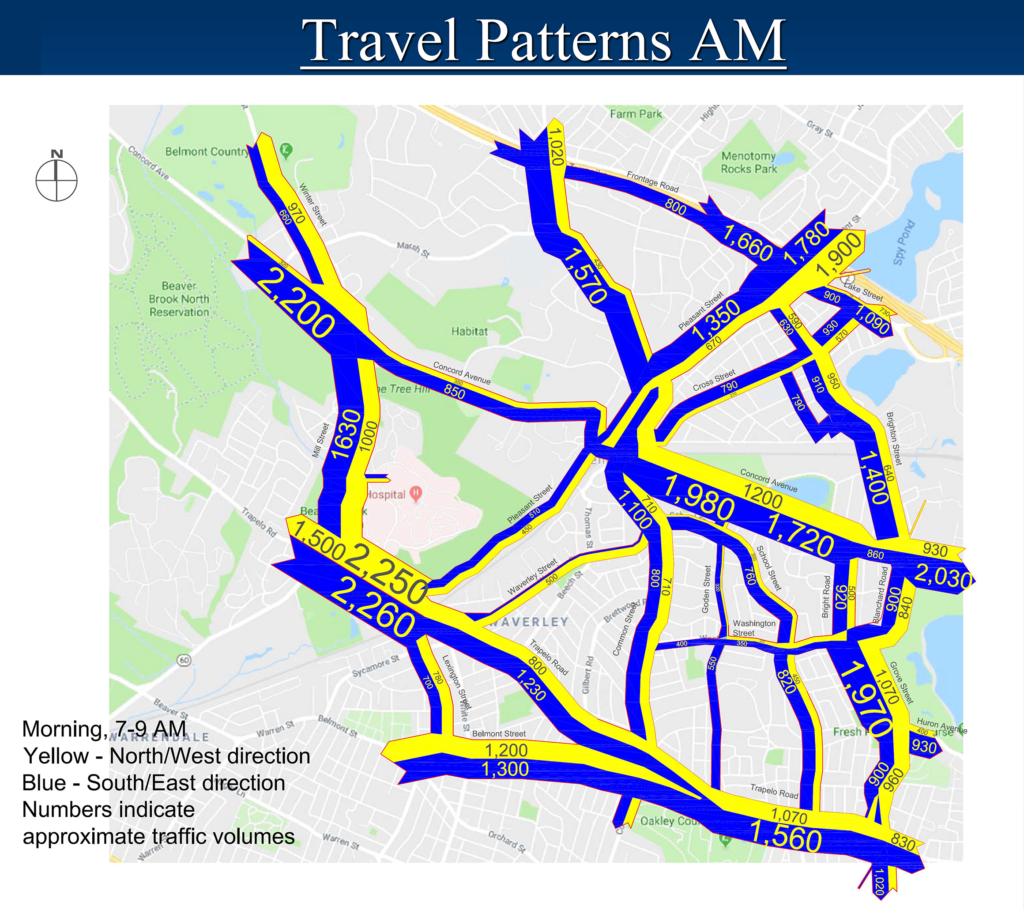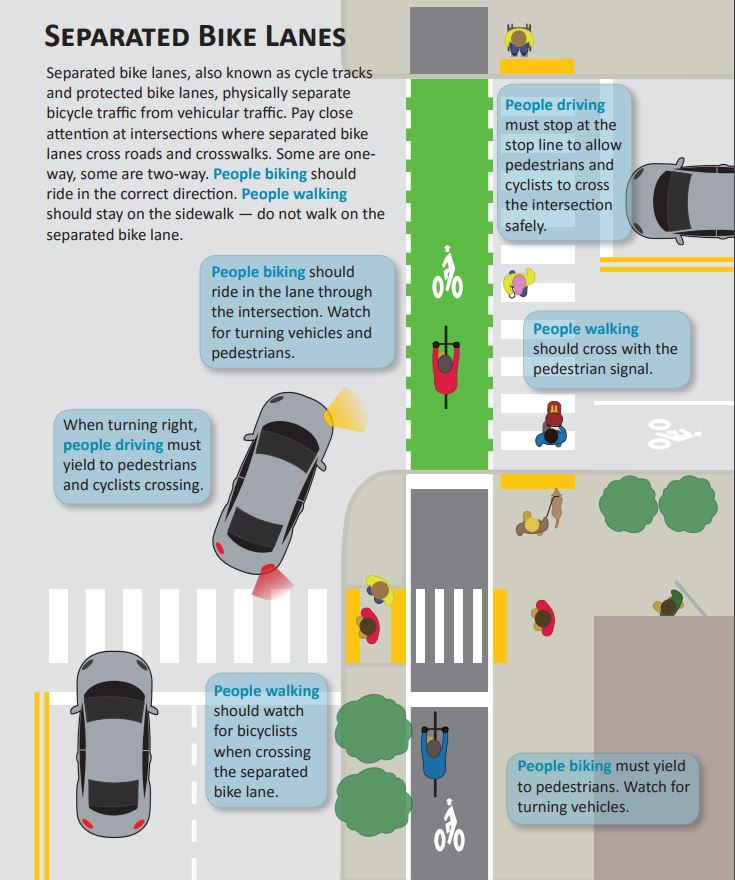
By Larry Link
The figures still catch my breath. A 2018–2019 pre-HS/MS construction study documented nearly 2,000 cars traveling down Concord Avenue from the snarl at the underpass (by most experienced hands, “unsolvable”) in Belmont Center to the High School-Middle School site opposite Goden Street, in just the morning 7 to 9 AM rush.
Of all vehicles clocked in that special Registry of Motor Vehicles (RMV) study using automated license plate reader information, 75% entered and left Belmont within 15 to 20 minutes but were registered/garaged in other towns! While we don’t have a new count yet, many Goden Street and Concord Avenue residents will attest that post-COVID traffic volumes are building back up.

Belmont’s morning traffic patterns, as shown in “Town of Belmont Town Wide Traffic Study,” April 1, 2019. Lines with light text on a dark background indicate traffic traveling south and east; dark text on a light background indicates north and westbound traffic.
That traffic may be the result of resumption of commuting as well as the heavy parent and student traffic to and from the new high school. This is not just twice a day, because many driving students make a third trip for lunches and free periods. This fall, the new middle school will open. The congestion and volumes will likely increase significantly on Hittinger, Baker, Trowbridge, Underwood, and yes, Concord Avenue, unless everyone makes the effort to carpool, bike, or walk as often as possible.
Concord Avenue’s protected bike lane
Several years ago, Belmont’s Traffic Advisory Committee (TAC) worked closely with Community Development, the High School/Middle School Building Committee, and that committee’s consultant, Nelson/Nygaard, to create a protected bike lane. That lane was a way to improve bicyclist safety on Concord Avenue and to encourage even more cycling along this major conduit between Belmont Center and what would become the campus for nearly 50% of our town students. Based on some resident concerns, TAC and the Select Board altered the protected bike lane beginning at the post office, leading into the confusing and dangerous intersection of Concord, Common, and Leonard Streets.
The protected bike lane will also link north/south access to the Chenery and Wellington/Burbank schools, and, one day, via the Community Path/Alexander Avenue bike and pedestrian underpass to the Winn Brook neighborhood. Parking was shifted from the curb, adjoining the moving lane, with a small “safety” buffer inserted between the lane and parked cars. While care is needed to exit a parked vehicle on either side, it better protects bicyclists from being doored than a narrower lane and moves them farther from automobile traffic. We now see signs on Concord Avenue which help drivers understand this important change.
Another major part of TAC’s recent work has been evaluating hotspots such as crosswalks and cut-throughs where drivers speed or ignore “Do Not Enter” signs or other basic rules of the road. TAC has recommended several speed tables, some implemented, some not, as well as closure or turn restrictions for some cut-through streets, and TAC is working with the town on safety issues such as high-priority crosswalks, cracked sidewalks (especially primary avenues to schools), striping, visibility issues concerning shrubbery and trees, and signage regarding parking, intersection setbacks, etc. Belmont police are unable to patrol everywhere and therefore enforcement is challenging.

Rules for driving near separated bike lanes, as depicted by Cambridge’s Vision Zero program. Source: City of Cambridge
The town’s dire funding situation hampers other traffic mitigation installations. It’s costly to install effective LED beacon crossing apparatus, erect pedestrian refuges in the middle of wide streets, hire more crossing guards for schools, paint “sharrows” on key streets to remind drivers to “share the row” (European origins), and accelerate sidewalk repairs and management. TAC tackles what issues it can, but whether most of its larger recommendations can be implemented is ultimately determined by our Select Board and the town’s very tight budget and inadequate staffing.
For example, the original HS Building Project Plan called for a 90-car student lot, but somewhere between Planning and Select Board approval, COVID-19 and supply chain costs, and scarce campus footprint, the lot (and tennis courts) fell off the drawing board. Students were allocated the northbound side of Concord Avenue, the “Ring Road,” and Underwood Pool parking areas, and eventually other parts of Concord Avenue. Students have always driven, and TAC appreciates this rite of passage and convenience for attending after-school sports and activities. However, this change imposes on residents and other users of Concord Avenue.
Roy Epstein, Select Board chair, also heads a special Neighborhood Traffic Working Group which has dealt with these high school/ middle school issues since 2018. I also sit on this task force. There are few easy solutions which satisfy everyone, and we continue to grapple with thorny issues that do not have clear and obvious solutions. One thing is certain: Our town has become much more urban in the last 20-plus years. It is not a reversible change.
Building on the recent “Slow Down/School Opens” sign campaign (a resident-led and funded effort), this coming year TAC will help to reenergize the Massachusetts Department of Transportation Safe Routes To School program and support principals and PTOs/PTAs to encourage biking and walking to all of our schools. TAC also will work with Safe Routes To School to organize a Bicycle Rodeo to teach biking safety skills to Belmont youth, and to renew efforts to win DOT grants for various traffic mitigation measures and equipment.
Another development was the collaborative School Committee/TAC Parent/Driver Survey last fall. The survey response rate was quite strong, and we now have a much better sense of what motivates people to drive, including:
- Cost of the school bus. Most students must pay a bus fee because they do not meet the Massachusetts-mandated distance from school to justify free transit
- Limitations and timing of bus routes (a full hour ahead of HS class start)
- How the bus routes sync with class schedules and after-school activities
- Perceived safety for bikers and walkers
As a result, the school department reduced its bus fee by $150. However, since the School Committee made it an all-encompassing charge, many half-day or half-year riders actually will experience a significant increase this year. Regardless, the bus is a great way to get students to schools and save a parent or caregiver unnecessary driving. More discussions will be needed to investigate better alignment of the route timing and school hours and maximize ridership and further cost reductions.
Still to be determined is where student drivers may park as the numbers balloon in the spring, and if the town should charge a parking fee. A fee could suppress unnecessary driving and subsidize the bus costs of other students. UCLA professor of urban planning Donald Shoup’s extensive research makes this point (See parkade.com/post/donald-shoup-the-high-cost-of-free-parking-summarized and www.shoupdogg.com for more information.) Belmont charges commuters and long-term parkers for all-day use of town streets or lots near the railroad station or town center, so why not students?
Belmont resident and Warrant Committee member Matt Taylor recently introduced the concept of a parking benefit district. Much like a neighborhood or commercial zone, a parking benefit district is an area where parking revenues offset traffic mitigation and fund neighborhood transit safety improvements such as crosswalk upgrades, special striping, and improved lighting along with more parking clerks and crossing guards.
Belmont driving tips
We all need to drive more carefully and be patient even as we endure the inevitable traffic jams and backups. We should avoid idling our engines as well (idling is illegal in Massachusetts; see “Idling Harms Your Car and Your Health,” Belmont Citizens Forum Newsletter, January, 2017.) Sadly, all of this has become more or less normal. The quieter pace and volumes of 20 or 30 years ago have yielded to a far more dense urban cityscape. We cannot wall ourselves off, but we can all try to drive a little less. We all want to reduce congestion and pollution.
In closing, here’s a challenge: How much more biking or walking can each of us work into our routines? It is a major sea-change for those who do not, and not everyone can. That said, a one-mile or less walk to your library or post office takes very little time or energy for those who are mobile. Factor in a bike, and most youth and middle-aged adults could accomplish a great deal without using a car. Can more students carpool, or bike on nice days?
Why not use September to try it out? Get on those walking shoes and find a small backpac —or pump up the tires and add a rack to your bike to support a briefcase, gym bag, or instrument. Then see if you can swap foot/bike for the car and make five to 10 trips to one of the town centers, the library, Town Hall, or school in the next few weeks. Bike to the local bakery or shop or drug store (or even work) just one to two times a week, and see how well it can work for you. I bet you will find it challenging at first, but rewarding and fun with practice. You will also notice some drivers are pretty bad and might benefit from retaking a driver ed course!
Certainly take advantage of these good weather days. And when you have to drive, see if you can organize carpools with others whenever possible. Combine errands to one trip, especially if you have to drive through a hotspot on your way in/out of Belmont.
You get the drill. Be creative. A lot of people making the extra effort can make a big impact over time. That’s what we need to move the needle on our congestion issue. While those non-Belmont cars are troublesome, “we (also) are the traffic.”
Larry Link is a member of the Transportation Advisory Committee, the Traffic Working Group–Middle and High School, and the Comprehensive Capital Budget Community, and is a Town Meeting Member for Precinct 1.


Sorry, the comment form is closed at this time.